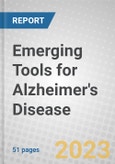The report provides an overview of AD, and the current diagnostic methods. The report explains the need for emerging tools for the early detection of the disease. Tools that have been approved are discussed, as well as tools in the development phase. The report does not include therapeutics approved or in the pipeline for AD.
The report covers the global market for emerging tools with a look at the regional markets of North America, Europe and Emerging Markets.
The report provides a detailed analysis of the current and future global market for emerging tools. Industry growth drivers, restraints and opportunities are also discussed. The report also provides a look at the competitive landscape, profiles of companies developing tools for the early detection of AD, and the impact of COVID-19 on the market.
Report Includes
- An overview of the global market for emerging tools for the early detection of Alzheimer’s disease
- Estimation of the market size and analyses of global market trends, with data from 2020 to 2022, estimates for 2023 with projections of compound annual growth rates (CAGRs) through 2028
- Highlights of the current and future market potential and quantification of market based on type and region
- Identification of market drivers, restraints and other forces impacting the global market and evaluation of current market size and forecast
- Detailed analysis of the regulatory framework and policies and product pipeline of the industry
- Market share analysis of the key companies of the industry and coverage of their proprietary technologies, strategic alliances, and other key market strategies and a relevant patent analysis
Table of Contents
Executive Summary
Alzheimer’s disease (AD) is a neurodegenerative disease that progresses along a continuum from preclinical disease to mild cognitive and behavioral impairment and finally dementia. Existing diagnosis methods include cognitive assessments, positron emission tomography (PET) scans, magnetic resonance imaging (MRI) and cerebrospinal fluid (CSF) tests. All these diagnostic methods are not routinely used for diagnosis as they are expensive and invasive. As a result, there is a substantial unmet need for earlier diagnosis with more cost-effective and less invasive procedures.
There is high demand for tests that are cost-, resource- and time-effective and that would help in the screening of suitable patients for clinical trials and also lead to early detection of the disease.
Notably, the development of effective drugs that can prevent, treat and cure AD begins with the ability to accurately diagnose people at an early stage of the disease. The recent approval of drugs by the U.S. Food and Drug Administration (FDA) for the treatment of early Alzheimer’s disease is a significant driver of demand for early detection. In 2021, the FDA granted accelerated approval to aducanumab, and in 2023 it granted accelerated approval to lecanemab. Aducanumab works by removing beta-amyloid from the brain, while Lecanemab works by blocking the formation of amyloid plaques in the brain. Other anti-amyloid monoclonal antibodies (mAbs) are in late-stage development and target the early stage of the disease.
Extensive research is ongoing for blood-based biomarker tests that are easily performed and inexpensive. Studies have indicated that these tests help improve the design of clinical trials for disease-modifying agents. The role of blood-based biomarkers includes primary care screening, diagnostics, predictive risk, i.e., risk for incident AD, risk for progression from mild cognitive impairment (MCI) to AD, disease monitoring, stratification into clinical trials, and pharmacodynamic or treatment response monitoring (positive or adverse). Research is also ongoing for digital biomarkers and tools that are based on artificial intelligence (AI) and other advanced technologies.
Blood tests authorized for clinical and research use include PrecivityAD from C2N Diagnostic; Quest AD-Detect from Quest Diagnostics; the HISCL ß-Amyloid 1-42 and 1-40 Assay Kits from Sysmex; and AlzoSure Predict from Diadem have launched their blood-based biomarkers products for clinical use. Products from other companies such as Fujirebio and Roche are for research use only. Retinal products from Optina Diagnostics and Cognoptix have also been authorized for research use only.
The global market for emerging AD tools was valued at $814.7 million in 2022 and is forecast to grow at a CAGR of 13.6% to reach a value of $1.7 billion by the end of 2028. This growth rate is attributed to the increasing prevalence of the disease, high demand in the market, many product approvals and launches in the forecast period, and extensive R&D efforts, increasing investments and funding, and the need to recruit the right patients for clinical trials. The North American region accounts for the highest share of the global market due to expenditures for extensive R&D, the presence of many major players, and increasing authorizations by the FDA.
Companies Mentioned
- Altpep
- Araclon Biotech
- C2N Diagnostics LLC
- Cognoptix
- Diadem Spa
- F. Hoffmann-La Roche AG (Roche)
- Fujirebio Diagnostics
- Quanterix Corp.
- Quest Diagnostics Inc.
- Sysmex Corp.








